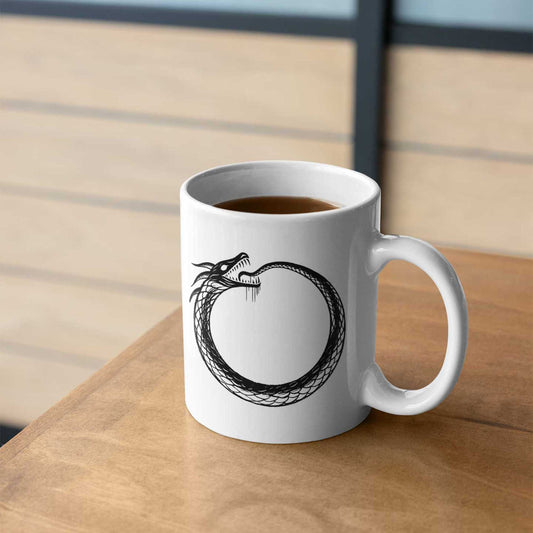Ouroboros

The Ouroboros is a compelling symbol that has intrigued humanity for thousands of years. At its simplest, the Ouroboros represents a serpent or dragon consuming its own tail, forming a complete circle that symbolizes the cyclical nature of the universe: creation out of destruction, life out of death. The Ouroboros eats its own tail to sustain its life, in an eternal cycle of renewal.
The earliest known appearance of the Ouroboros motif is in the "Enigmatic Book of the Netherworld," an ancient Egyptian funerary text from the tomb of Tutankhamun, which dates to the 14th century BCE. In this culture, the Ouroboros was associated with the god of the afterlife, Osiris, and the sun, and represented the travels of the sun disk.
From Egypt, the symbol entered Greek philosophical traditions, most notably with the Gnostics and alchemists. For the Gnostics, the Ouroboros was a symbol of the world's cyclic nature and of the divine unity of all things. Alchemists, on the other hand, took it to represent the transmutation of base materials into noble ones, the unification of opposites, and the philosopher's stone – the ultimate alchemical substance capable of turning base metals into gold or granting immortality.
In medieval alchemy, the Ouroboros became a common alchemical symbol, denoting the refinement of substances and the unity of the philosophical stone. Its circular shape was seen as an allegory for the alchemist’s quest: an endless process of purifying and combining substances in the search for enlightenment and perfection.
The Ouroboros also appears in various forms across different cultures and periods: in Norse mythology as the serpent Jörmungandr, one of the three children of Loki and Angrboða, which grew so large that it could encircle the world and grasp its own tail; in the Hindu tradition as a dragon circling the tortoise that supports the four elephants that carry the world on their backs.
In modern times, the Ouroboros has been interpreted through the lens of psychology by Carl Jung, who saw it as an archetype and the basic mandala of alchemy. The Ouroboros encapsulates the unconscious desire for introspection and the personal journey of self-discovery and transformation.
In popular culture, the Ouroboros symbolizes the endless cycle of nature's endless creation and destruction, life and death, and chaos and order. It serves as a potent metaphor for the human condition and our quest for understanding in a universe that is always changing yet remains the same in many ways.
The Ouroboros is not merely an ancient or mystical symbol; it carries deep meaning and relevance even today, representing the timeless nature of the universe and our place within it, the eternal struggle of life, and the promise of renewal and continuity. Whether you see it as a representation of the cosmos, nature's life cycle, or the human psyche's quest for completion, the Ouroboros remains a profound symbol of the eternal unity of all things.

